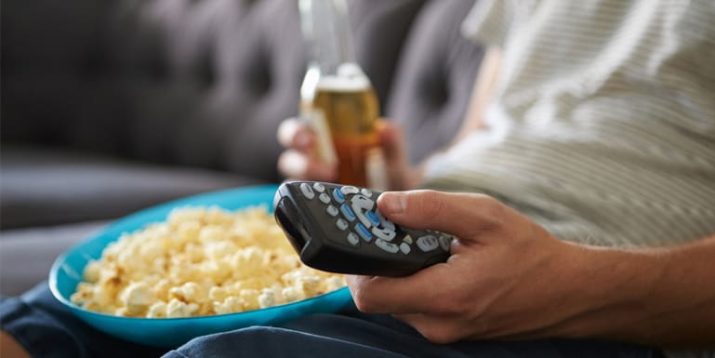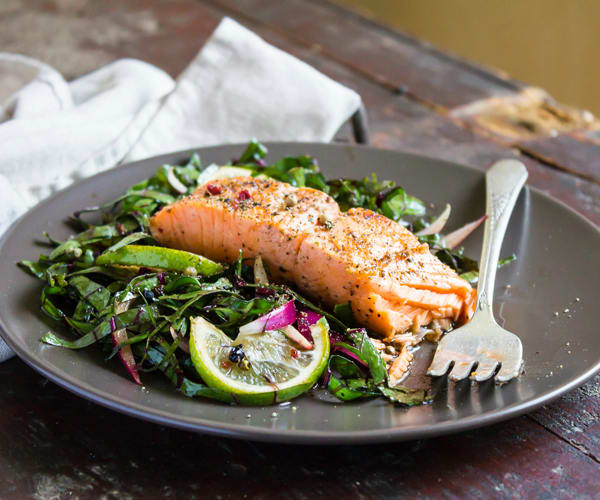How to Stop Mindless Eating

You know the story: You woke up at dawn to squeeze in a workout, had a tiring day at work, ran errands, did chores, walked the dog, put the kids to bed, and finally get 30 minutes to yourself.
You collapse on the couch for some mindless television watching, a bowl of buttered popcorn and beer/wine/diet soda glass nearby.
As you unwind, you’re likely not thinking about how much popcorn you’re shoveling into your mouth… unless your fingers scrape the bottom of the deep porcelain bowl, confirming that — yes — you just ate a large bowl of greasy popcorn.
Eating on autopilot, better known to researchers as “mindless eating,” happens because we’re aware of only a fraction of the food decisions we make.
Because of this mindlessness, our environment can impact what and how much we eat.
Our surroundings consist of cues that we often can’t control, such as portion sizes we’re served, the volume of take-out food containers, social interactions while eating, distractions while eating, and even the degree of effort it takes to get food.
How many decisions do you make per day related to food? 10? 20? Maybe even 30?
Whatever that number is, you likely didn’t come close to what Dr. Brian Wansink, director of the Cornell Food and Brand Lab, found with an experiment he conducted to unearth how many food-related decisions people make each day on average, and how their environment affects those choices.
When 139 participants were asked how many food decisions they make daily, they guessed an average of 14.4 decisions.
In reality, they were making over 200 food decisions per day!
If you’re shocked, that’s because many of those decisions are made under snap judgment while functioning on autopilot.
Most people flip this “autopilot” — or mindless — switch on when they rush to get out the door in the morning, shuffle through back-to-back meetings, or check email through their lunch break.
Behavioral scientists Wendy Wood and David T. Neal have done influential work on the science of habits.
They have found that people often fail at diet and exercise plans because the decision to pick a side salad over french fries is affected by multiple cues and triggers (such as time of day or location) that can cause repetition of past responses.
In other words, our habits, both healthy and unhealthy, are so ingrained in what we do each day that we often make choices without really thinking about them.
According to Wood and Neal, “failure to change doesn’t necessarily indicate poor willpower or insufficient understanding of health issues, but instead the power of situations to trigger past responses.”
This is powerful stuff!
It acknowledges you can be armed with the best knowledge in the world, but your environment can still get the best of you if you don’t pay attention.
In order to replace unhealthy behaviors with healthy ones, you need to pay conscious attention.
The upside: You may not need a diet overhaul to change your unhealthy eating behaviors. Call them tricks or nudges, but the following five changes can help you break out of the mindless eating mold.
5 Tricks to Stop Mindless Eating
1. Plate everything what you eat
When you plate your meals and snacks before eating, you see everything you’re going to eat all at once.
As a result, you’re less likely to mindlessly crunch through a jumbo bag of potato chips.
So, does that mean that, as long as you put your food on a plate, you’re good to go — even if that plate runneth over?
(Nice try. See tip #2 below.)
2. Use small plates and bowls
Research shows that people underestimate how much they serve themselves when using larger dishes and bowls.
A large plate or bowl can “trick” you into thinking that the amount of food in them look smaller than it actually is.
Wansink found that campers given larger bowls ate 16 percent more cereal at breakfast than those given smaller bowls, but, despite eating more cereal, they underestimated what they ate by seven percent.
Even when you’re serving food to others, small bowls work in your favor.
Wansink’s study showed that participants who took Chex Mix out a gallon-size bowl served themselves 53 percent more and ate 59 percent more than those who served themselves from a half-gallon bowl.
In light of this evidence, Wansink advocates for a small plate movement.
After all, the standard plate size has increased from 9.6 inches to 11.8 inches since 1900 — and so have our rates of obesity and being overweight.
By plating everything you eat before you eat it — within reason, of course; if you want to eat an apple for a snack, you don’t have to put that on a plate — and using smaller bowls and plates (i.e., salad plate instead of dinner plate), you’ll get a better handle on just how much you’re eating.
To take it a step farther and make sure you’re eating the ideal amount of macronutrients (carbs, protein, fats) and calories each day to help you lose weight, follow a Beachbody nutrition plan.
Simply add the food you want to eat to the correct color Beachbody Portion Control Containers (red for protein, yellow for carbs, for example) to help you rein in the amount of food you eat.
3. Avoid “bottomless” situations
Don’t be tempted by the value proposition of “bottomless” fries, margaritas, and breadsticks.
In a study by Wansink, unwitting diners were served tomato soup either from bowls that were refilled continuously through tubing that ran underneath the table to the bottom of the bowl, or from regular bowls that did not refill.
Those who ate from the “bottomless” bowls ate 73 percent more soup than those with normal bowls — without believing that they had done so.
A powerful cue for many of us to stop eating is when the plate or bowl is empty. You don’t necessarily get that cue if a charming server continuously refills your food.
4. Serve yourself 20 percent less

In his book, Mindless Eating, Wansink recommends that you serve yourself, then put back about 20 percent of what you originally put on your plate.
He calls this the “mindless margin,” the zone in which we can slightly overeat or even under-eat without noticing it.
He theorizes that most of us can trim 20 percent of our food intake without feeling deprived.
Another way to think about this concept: If you overeat as few as 100 calories each day for a year and don’t burn those extra calories through activity, you’ll rack up 36,500 excess calories per year (365 days in a year x 100).
This can cause you to gain 10 pounds in one year (36,500 calories divided by 3,500 — the approximate amount of calories in one pound — equals 10.4 pounds.).
If that doesn’t shock you, consider the longer-term effects of eating 100 extra calories per day and not burning them: After 10 years of this habit, you can add 100 pounds to your frame!
Manipulate the mindless margin to create healthier eating habits, including transitioning to a cleaner diet.
You won’t notice eating 20 percent less rice nor will you notice eating 20 percent more Brussels sprouts. Use it to your advantage!
5. Practice mindfulness and slow down
It may sound woo, but it’s true! Mindfulness can be beneficial for weight loss, and mindful eating is a strategy recommended by nutrition experts to help people get more enjoyment out of food while eating less.
The idea is not to eat or to stop eating when you’re distracted, such as when you’re chatting on the phone, watching television, or checking email.
Instead, you sit down to enjoy a meal, fully committed to savoring every bite slowly and enjoying each aroma, taste, and texture before swallowing that bite.
The 20-Second Takeaway
To stop mindless eating, we first need to understand and accept that many of the choices we make about food are made without deep thought or intention — they’re made by habitual default.
We overeat and gain weight, often without realizing the small daily choices we make that contribute to this cycle of excess.
Become a more mindful eater by plating everything you eat in small bowls or on salad plates, removing about 20 percent of what you put in those bowls or on plates, avoiding buffets, and “endless” servings at restaurants, and savoring your food for as long as possible before swallowing.

